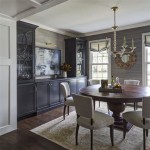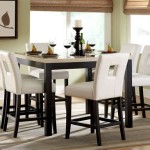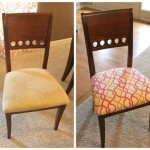Couch For Dining Room Table: A Modern Seating Alternative
The traditional dining room setup typically involves a table surrounded by chairs. However, contemporary design trends and space-saving considerations are leading to the adoption of alternative seating arrangements. One such trend is incorporating a couch or banquette as a seating option along one side of the dining room table. This approach offers a unique blend of comfort, style, and functionality, and can be particularly advantageous in specific spatial contexts.
This article explores the considerations involved in using a couch for dining room table seating, examining its benefits, potential drawbacks, and practical aspects of selection and integration. It aims to provide a comprehensive understanding of this seating alternative, enabling informed decisions about its suitability within diverse dining room settings.
Space Optimization and Versatility
One of the primary motivations for choosing a couch or banquette over individual chairs is space optimization. In smaller dining rooms or open-plan living areas where space is at a premium, a couch can be strategically placed against a wall, maximizing the usable floor area. This arrangement often allows for a larger dining table without compromising overall room circulation.
Furthermore, a couch offers greater versatility than individual chairs. It can comfortably accommodate varying numbers of diners, providing a flexible seating solution for both intimate meals and larger gatherings. Unlike fixed chairs, the couch can easily adjust to accommodate an extra guest or two, eliminating the need for additional seating cluttering the room.
In addition to its functional benefits, a couch can contribute to a more relaxed and inviting atmosphere in the dining room. The soft upholstery and inviting design create a more comfortable and less formal dining experience, encouraging extended conversations and a more leisurely pace. This can be particularly appealing in modern homes that prioritize comfort and informality.
The versatility extends beyond dining. A couch positioned against a wall can also serve as a comfortable lounging area when not in use for meals. This dual functionality makes it a particularly attractive option for multi-purpose spaces where the dining area also serves as a living or entertaining space. The couch can then become a central hub for family activities, seamlessly transitioning from mealtime to relaxation.
Moreover, incorporating storage into the couch design, such as built-in drawers or lift-up seating, can further enhance its space-saving potential. This provides a convenient and discreet storage solution for dining essentials, such as placemats, napkins, or even serving dishes, further decluttering the dining area.
The use of a couch can visually expand the space. By replacing individual chairs with a single, continuous seating element, the room appears less cluttered and more open. This is particularly beneficial in smaller dining rooms where maintaining a sense of spaciousness is crucial. The clean lines and uninterrupted surface of the couch contribute to a more streamlined and visually appealing aesthetic.
Considerations for Comfort and Ergonomics
While a couch offers certain advantages, careful consideration must be given to comfort and ergonomics to ensure a pleasant dining experience. Traditional dining chairs are designed with specific seat heights and backrests to promote proper posture and support during meals. A standard couch, however, may not always meet these ergonomic requirements.
The seat height of the couch should be carefully considered in relation to the height of the dining table. Ideally, the seat height should allow diners to comfortably reach the table without having to strain their necks or shoulders. A seat height that is too low can lead to slouching and discomfort, while a seat height that is too high can make it difficult to reach the table comfortably.
The depth of the couch seat is another important factor. A seat that is too deep can make it difficult to sit upright and maintain proper posture. Diners may find themselves leaning back too far, which can strain the lower back. Conversely, a seat that is too shallow may not provide adequate support for the thighs. The ideal seat depth allows diners to sit comfortably upright with their feet firmly planted on the floor.
The backrest of the couch should provide adequate lumbar support. A backrest that is too low or too soft may not provide sufficient support for the lower back, leading to discomfort and fatigue. A backrest that is too high or too firm may feel restrictive and uncomfortable. The ideal backrest provides gentle, yet firm, support for the lumbar region, promoting proper posture and reducing strain on the back muscles.
Upholstery plays a critical role in comfort. Durable and easy-to-clean fabrics are desirable for a dining setting, as spills and stains are inevitable. Leather, microfiber, or stain-resistant synthetic fabrics are popular choices. The cushioning should be firm enough to provide support, but soft enough to provide comfort. Overly plush cushioning may become uncomfortable during extended meals.
To address potential ergonomic concerns, consider adding cushions or pillows to the couch. These can be used to adjust the seat height, depth, or backrest support, ensuring a more comfortable and customized dining experience. They can also add a touch of style and personality to the dining room decor.
It's also important to note the potential for uneven wear. The seats on a couch used regularly for dining may experience more wear and tear than those used less frequently. Rotating cushions and ensuring even weight distribution can help to mitigate this issue.
Style and Aesthetic Integration
The choice of couch style should complement the overall aesthetic of the dining room. A wide range of styles, from modern and minimalist to traditional and ornate, are available. Selecting a couch that aligns with the existing decor creates a cohesive and visually appealing space.
In a modern dining room, a streamlined couch with clean lines and neutral colors can create a sophisticated and understated look. Leather or sleek synthetic fabrics are popular choices. Accent pillows in bold colors or geometric patterns can add a touch of visual interest. Consider couches with metal legs for a contemporary touch.
For a traditional dining room, a more ornate couch with tufted upholstery and decorative details can create a sense of elegance and formality. Velvet or patterned fabrics are often used. Pillows with tassels or embroidery can add a touch of luxury. Consider couches with wooden legs for a classic touch.
Consider the color of the couch in relation to the other elements in the dining room. A neutral-colored couch can serve as a versatile backdrop, allowing for greater flexibility in accessorizing with pillows, artwork, and other decorative items. A bold-colored couch can serve as a focal point, adding a touch of drama and personality to the space.
Scale and proportion are crucial in achieving a harmonious aesthetic. The size of the couch should be appropriate for the size of the dining table and the overall dimensions of the room. A couch that is too large can overwhelm the space, while a couch that is too small may look insignificant. The height of the couch should also be carefully considered in relation to the height of the dining table.
Lighting plays a crucial role in enhancing the aesthetic appeal of the couch. Proper lighting can highlight the texture and color of the upholstery, creating a warm and inviting atmosphere. Consider adding a floor lamp or table lamp near the couch to provide additional lighting for dining or reading. Dimmer switches can be used to adjust the lighting to suit different moods and occasions.
Accessories can be used to personalize the dining area. A carefully chosen rug can define the dining space and add warmth and texture to the room. Artwork, plants, and decorative objects can add personality and visual interest. These elements can be used to tie the couch into the overall design scheme, creating a cohesive and visually appealing space. Consider adding a console table behind the couch for displaying decorative items or providing additional surface space.
Ultimately, the choice of a couch for dining room table seating is a matter of personal preference and design considerations. By carefully considering the factors discussed above, it is possible to create a stylish and functional dining space that reflects individual tastes and lifestyle.

13 Sofa At Dining Table Ideas Decor Home

13 Sofa At Dining Table Ideas Decor Home

Living Room Meets Dining The New Way To Eat In

When A Banquette Isn T In The Budget Go For Kitchen Sofa West Main

Breakfast Room Banquettes Addicted 2 Decorating

Cozy Up To A Loveseat At The Table

7 Ways To Incorporate A Sofa In Dining Room Q Furniture

Sofa Dining Recovergirl

Dining Room Gray Sofa Design Ideas

7 Ways To Incorporate A Sofa In Dining Room Q Furniture








